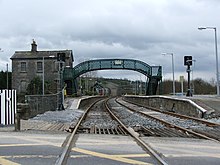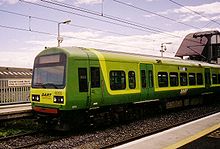Rail transport in Ireland
The rail transport in Ireland is on 2,259 kilometers of broad gauge unwound from 1600 mm, of which 1919 km in the 26 southern counties of the Republic of Ireland and 340 km in the northern six counties of Northern Ireland (2005).
history
The history of the railroad began in Ireland in 1834, just nine years after the world's first railroad opened on the neighboring British island. The route network reached its greatest extent in 1920 with 5600 kilometers. In the beginning different gauges were used: 1435 mm ( standard gauge ) between Dublin and Kingstown (today Dún Laoghaire ), 1575 mm for the Dublin and Drogheda Railway , 1880 mm for the Ulster Railway . A law of 1846 established a broad gauge of 1600 mm for Ireland and existing lines with different gauge were converted to it. Since it is an island operation , it has remained with this gauge, which was later also generally called Irish broad gauge.
When the Irish Free State separated from the United Kingdom in 1922 , but what is now Northern Ireland remained there, the new international border also cut a number of railway lines. In 1925, the various railway companies in the Irish Free State were merged to form Great Southern Railways . This was merged with the Dublin United Transport Company in 1945 to form what is now Córas Iompair Éireann (CIÉ).

The exception was the Great Northern Railway , which operated numerous routes that crossed the inner-Irish border. Border controls and the different behavior of the two states during World War II (the Republic of Ireland remained officially neutral ) harmed this railway company. After a long decline, it was nationalized in 1953 and initially operated as a joint property of the Republic and Northern Ireland as a condom line. But that was politically undesirable. In May 1958, the company was therefore dissolved and divided between the Córas Iompair Éireann (CIÉ) on the one hand and the Ulster Transport Authority , with all types of vehicles being distributed equally. The Ulster Transport Authority then shut down most of the cross-border routes, which ultimately forced CIÉ to also abandon its parts of the route that now ended at the border. This and the closure of branch lines have now more than halved the network compared to its greatest expansion.
In 1987 CIÉ was converted into a holding company and the independent rail transport company Iarnród Éireann was founded as an operating company for the rail transport sector .
Northern Ireland Railways operates rail transport in the north and Iarnród Éireann in the south . Both companies are subsidiaries of state transport companies, whose tasks also include bus and other road transport companies, Translink in the north and CIÉ in the republic. The railways in Northern Ireland were not affected by rail privatization in Great Britain .
Rail network
Of the 1919 kilometers in the republic, 497 km are double-track, in the north 140 km of 340 km. In the Republic of Ireland the 52 km long routes of the suburban railways of the capital Dublin (DART = Dublin Area Rapid Transit ) are electrified, in Northern Ireland only diesel vehicles are used.
From the once tightly knit network, the main routes that have been left are mainly star-shaped from Dublin, including the connection with Belfast and the network there.
Traffic performance
In 2005, 7.4 million passengers were carried in the north, with 236 million passenger kilometers being made. In the south there were 37.7 million passengers with 1781 million person-kilometers.
Dublin and Belfast are linked by an express train line jointly operated by the railroad companies of the Republic and the North under the brand name Enterprise . There are no border controls. Eight pairs of trains run Monday to Saturday and five on Sundays. The scheduled travel time is approximately two hours.
In 2004, Iarnród Éireann transported 2.3 million tonnes at 399 tonne kilometers. In 2005 it was only 1.5 million tons or 303 ton kilometers.
tram
After the tram was shut down in Dublin between 1949 and 1959, the Luas tram has been operating here since 2004 . Luas with its two lines is operated by Veolia Transport . It drives on standard gauge of 1435 mm and is supplied with 750 volts direct current . This gauge is unusual for Ireland, but is common on trams in other countries, such as Germany.
Subway
The introduction of a subway is planned in Dublin . Earlier plans included two lines, Metro North and Metro West , which are to be created in a public-private partnership . Like the tram, the metro will run on standard gauge and use the same electricity system, so that the vehicles can also run on the other lines.
More recent plans under the name MetroLink only envisage the construction of a single underground line with a similar course as the Metro North . It should lead from Swords north of Dublin, via the airport and the city center to Charlemont. The opening date is set for 2027. The conversion of the Green Line tram route between Charlemont and Sandyford into a metro route is also planned at a later date . The Metro West route , which is a tangent to the northwest around Dublin and primarily aims to relieve the M50 ring road, is currently not being pursued any further.
Peat tracks
In addition to the public rail network, Bord na Móna (German peat agency ) operates a narrow-gauge network with a track width of 3 feet = 914 mm and about 1365 km in length, with which the excavated peat is transported, e.g. B. on the Clonmacnoise and West Offaly Railway . 850 km of this are permanently laid tracks, the rest will be laid and dismantled as required. Around 5 million tons of ground peat are transported every year.
Monorail
From 1888 to 1924, the Listowel and Ballybunion Railway operated in County Kerry . It was the world's first commercially operated monorail . It was operated according to the Lartigue system. In 2003 a replica of this runway was opened on a 1000 meter long route in Listowel .
Expansion planning
With "Transport 21", the Irish government has presented a plan to expand transport on the island, which also includes the revitalization of rail traffic.
CIÉ is planning to expand rail traffic, including by revitalizing the approximately 58-kilometer-long railway line from Ennis to Athenry . It was reopened on March 30, 2010 and for the first time in 34 years it enables direct rail traffic between Limerick and Galway . In a further phase, the reconstruction of the line leading further north is planned.
In the north, some routes have been relocated.
See also
literature
- Modern railcars, but hardly any freight traffic . In: Eisenbahn-Revue International 7/2012, p. 370f. [Status report]
Web links
- Iarnród Éireann (English)
- Northern Ireland Railways (English)
- Information on the Metro from the Railway Procurement Office
- About Metro and Luas- projects in the Dublin area (English)
- Photos on the "European Railway Server"
- Vehicle directory on the "European Railway Server" (English)
swell
- Statistical information is based on statistics from UIC (Union Internationale des Chemins de Fer) or information on http://www.bnm.ie
Individual evidence
- ↑ Railway Regulation (Gauge) Act 1846 (PDF; 452 kB)
- ↑ Websites of the MetroLink project (English) , metrolink.ie, accessed on June 9, 2019.
- ↑ Paul Hoshford: Dublin's Metrolink will only go north - south until at least 2035 , thejournal.ie, March 23, 2018, accessed June 9, 2019.






